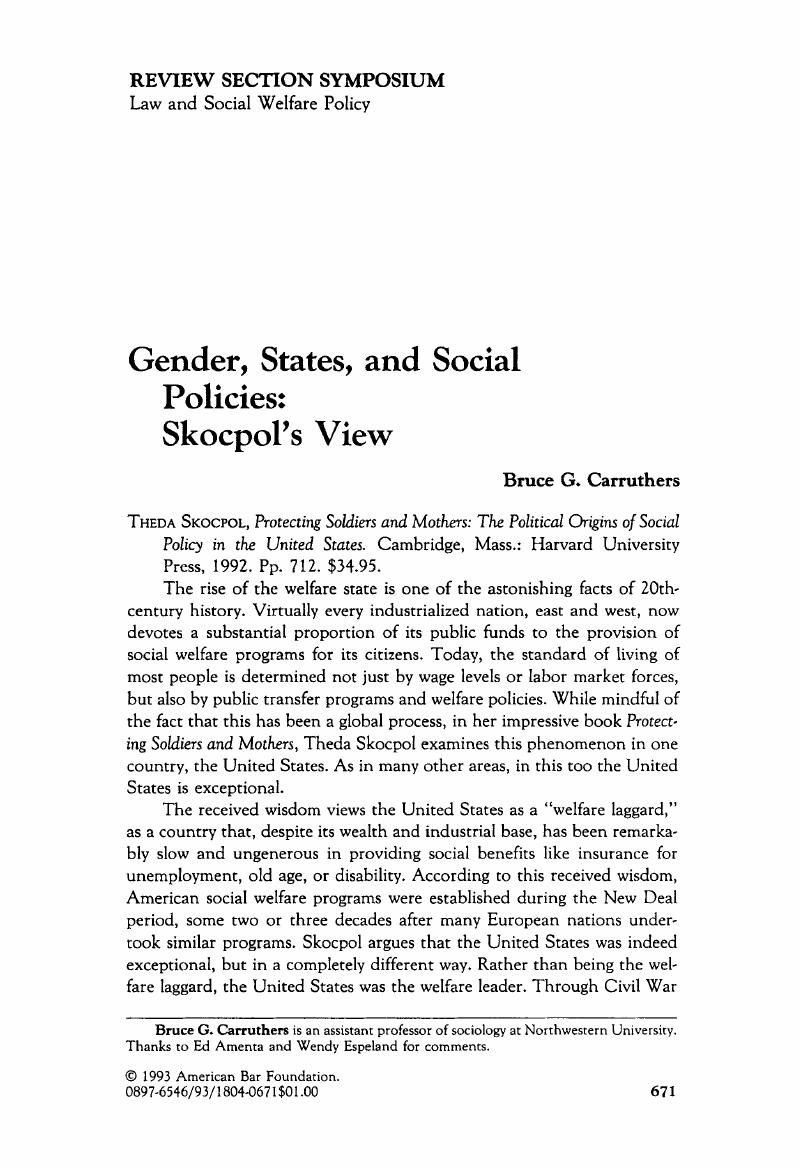Article contents
Gender, States, and Social Policies: Skocpol's View
Published online by Cambridge University Press: 27 December 2018
Abstract

- Type
- Review Section Symposium
- Information
- Copyright
- Copyright © American Bar Foundation, 1993
References
1 U.S. Bureau of the Census, Statistical Abstract of the United States, 1991, table 509 (Washington, D.C.: Government Printing Office, 1991).Google Scholar
2 For a fuller discussion, see Edwin Amenta, “The State of the Art in Welfare State Research (on Social Spending Efforts in Capitalist Democracies since 1960),”Am. J. Soc. (forthcoming); Edwin Amenta & Bruce G. Carruthers, “The Formative Years of U.S. Social Spending Policies: Theories of the Welfare State and the American States during the Great Depression,” 53 Am. Soc. Rev. 661 (1988).CrossRefGoogle Scholar
3 Stephen Skowronek, Building a New American State: The Expansion of National Administrative Capacities, 1877–1920 (Cambridge: Cambridge University Press, 1982).CrossRefGoogle Scholar
4 See Morton J. Horwitz, The Transformation of American Law, 1780–1860, at 1–30 (Cambridge: Harvard University Press, 1977).Google Scholar
5 See Karl Mannheim, Ideology and Utopia (London: Routledge & Kegan Paul, 1936).Google Scholar
6 See Skocpol's discussion at 256–58 of the Supreme Court's 1905 decision in Loch-ner v. New York, 198 U.S. 45 (1905).Google Scholar
7 For a fuller discussion of men's and women's separate spheres, see Baker, Paula, “The Domestication of Politics: Women and American Political Society, 1780–1920,” 89 Am. Hist. Rev. 620 (1984).CrossRefGoogle Scholar
8 Muller v. Oregon, 208 U.S. 412 (1908).Google Scholar
9 Cambridge: Cambridge University Press, 1979.Google Scholar
10 It may be that this difference between Skocpol's two books is not a deeply principled one and that ideology simply doesn't matter as much for revolutions as for welfare policy. However, given various articles written between her two major books, which indicate a shift, 1 suspect that Skocpol has changed her position and now grants more significance to ideological factors. See the exchange with William Sewell over the role of ideology in revolutions, in Sewell, William H. Jr., “Ideologies and Social Revolutions: Reflections on the French Case,” 57 J. Mod. Hist. 57 (1985), and Skocpol, Theda, “Cultural Idioms and Political Ideologies in the Revolutionary Reconstruction of State Power,” 57 J. Mod. Hist. 86 (1985).CrossRefGoogle Scholar
11 See Alexis de Tocqueville, Democracy in America 189, 295, 513, trans. George Lawrence (New York: Doubleday & Co., 1966). For more on the organization of women's groups, and how it influenced Progressive Era politics, see Clemens, Elisabeth, “Organizational Repertoires and Institutional Change: Women's Groups and the Transformation of U.S. Politics, 1890–1920,” 98 Am. J. Soc. 755 (1993).CrossRefGoogle Scholar
12 For a useful analysis of the importance of cultural category systems, see Mary Douglas, How Institutions Think 10, 63-65 (Syracuse: Syracuse University Press, 1986).Google Scholar
13 See, e.g., Skocpol, Theda & Somers, Margaret, “The Uses of Comparative History in Macrosocial Inquiry,” 22 Comp. Stud. Soc'y & Hist. 174 (1980).CrossRefGoogle Scholar
14 Claudia Goldin, Understanding the Gender Gap: An Economic History of American Women, table 2.1 (New York: Oxford University Press, 1990) (“Goldin, Understanding the Gender Gap”).Google Scholar
15 Id. at table 3.3.Google Scholar
16 For a discussion of organized black women's groups in Progressive Era Chicago and their relation to white women's groups, see Sarah Gatson, “Women in Movement during the Progressive Era: Race, Class, and Organized Women's Responses to Protective Labor Legislation in Illinois” (Northwestern University, Evanston, Ill., 1993).Google Scholar
17 Goldin, Understanding the Gender Gap 195.Google Scholar
18 Jeremy Atack & Fred Bateman, “Whom Did Protective Legislation Protect? Evidence from 1880” (National Bureau of Economic Research Working Paper No.33, 1991).CrossRefGoogle Scholar
- 2
- Cited by




